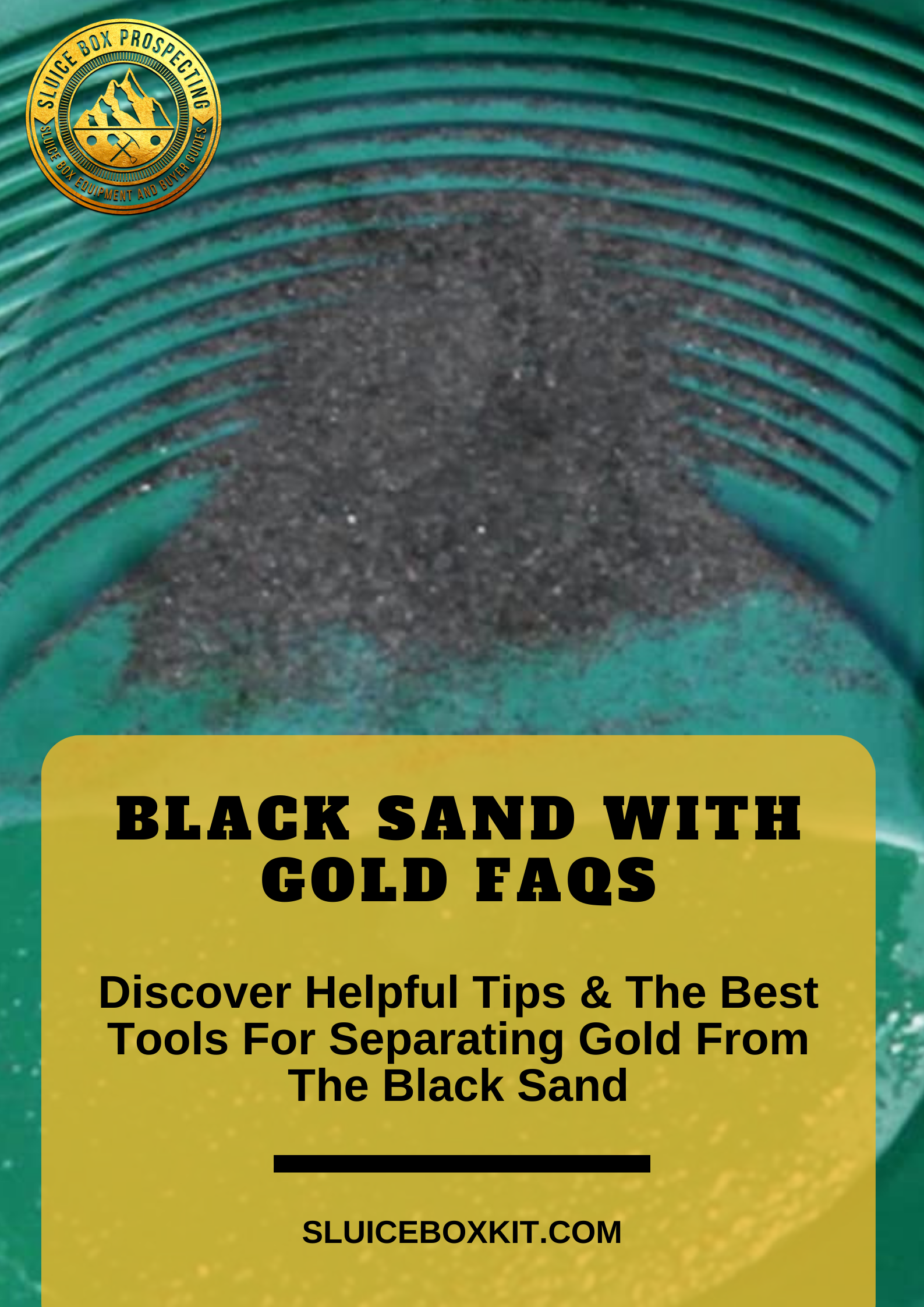Black sand is a type of soil found near rivers and beaches. It is made up of tiny pieces of minerals, including quartz and feldspar. When prospectors find this type of soil, they often assume gold is nearby because it’s a common indicator of the precious metal. Prospectors need to become proficient at identifying black sand with gold and extracting it.
The black sand concentrate is easy to identify because it is strikingly different from the other materials in your pan. It is usually darker, heavier, and coarser than the quartz sand and will settle at the bottom of your pan if you let it sit long enough.
Black sand can be a challenge to deal with if you’re new to prospecting. But with a bit of practice, you’ll be able to separate the gold from the sand in no time.
This article will answer some frequently asked questions about black sand with gold. You’ll also find tips and tricks to help you learn how to separate the two. We will also recommend some of the best tools for the job!
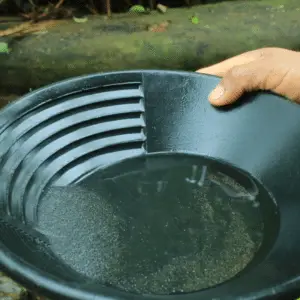
Is Black Sand A Good Indicator For Gold?
Table of Contents
Black sand is not a guaranteed indicator of gold, but it can be a good sign that the precious metal is nearby. Gold is often found in areas where there is black sand. Rivers and waves usually bring the two materials together.
Black sand is created when rocks are eroded by water. The water washes away the lighter rock particles, leaving the heavier minerals. These rich minerals include things like quartz and feldspar. Over time, this process can create large deposits of black sand. Black sand is often found near rivers and beaches because that’s where the water has the most energy to wash away rocks.
Black sand is a heavy, glossy, partly magnetic mixture of usually fine sand found as part of a placer deposit. The mechanical concentration of resistant heavy minerals occurs in the beach environment, mostly under high energy conditions, and the source rocks mainly control their petrological composition. – almanhal.com
If you’re panning for gold and you see black sand in your pan, it’s worth paying attention to see if any flakes and nuggets are mixed in. The two most common minerals in black sand are hematite and magnetite. Hematite is a type of iron oxide, and it’s often found in beach sands. Magnetite is a type of iron oxide that’s attracted to magnets, also common in beach sands.
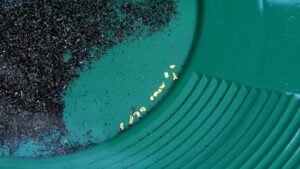
What Kind of Black Sand Contains Gold?
Not all black sand contains gold, but it is a good sign if you find it while prospecting. The best way to find out if there is gold in your black sand is to take a sample and assay its quality. You can also use a gold pan, pinpointer, magnet, or metal detector to scan the black sand for gold.
Or, in some cases, you may need to smelt the minerals to separate the gold from the other minerals. However, it is crucial to ensure large amounts of black sand with gold to make the smelting cost worthwhile. If not, you may want to consider another method.
How To Separate Gold From Black Sand
The best way to separate gold from black sand is to use a gold pan. This process is the most common method prospectors use to separate the two materials. If you don’t have a gold pan, you can also use a magnet to remove the gold from the black sand.
Black Sand Gold Panning Techniques
Extracting fine gold from black sand with at least an 8″ gold pan and using the Georgia swirl to create a centrifuge will allow the gold to separate from the black sand and accumulate together.
Also, gently tapping on the edge while backwashing with water will pull the sand away from the gold.
As the gold accumulates around the outer edge of the pan, you can use a snuffer to remove the backline of gold and then continue refining the black sand with gold.
How To Use A Magnet To Remove Gold From Black Sand
Before using a magnet to recover gold from black sand, the sand must be completely dry and powdery or submerged in water. Simply pass the magnet over the material, slightly above it, to remove the black sand from the gold. Next, you will deposit the black sand that you collect in a separate pan containing water.
Using three separate pans is necessary to ensure that you do not accidentally lose gold as you remove sand from the original material, after collecting and refining the black sand several times, looking for gold, using a snuffer bottle to collect the remains each time.
Using a magnet to separate gold from black sand can be time-consuming, and you risk losing fine gold flakes. Properly using a gold pan to separate black sand with gold is a much faster and safer way to process the material.
Best Tools For Separating Black Sand From Gold
There are four main types of tools for separating black sand from gold:
- Gold pan
- Gold magnet
- Blue Bowl Concentrator
- Gold Spiral Wheel
- Gold Smelting Kit
Gold Pan: A gold pan is one of the essential tools for prospecting. It is a simple device used to separate gold from black sand.
When looking for a gold pan to use for black sand, it is essential to find one that is durable and large enough. Ideally, at least an 8″ pan provides plenty of room to shift the material to effectively separate the gold and sand.
The Garrett SuperSluice Gold Pan: This gold pan is designed with a ridged bottom that makes it easy to extract gold from black sand; it measures 15″ rim to rim. The bottom of the pan is 9″ across. The depth of the pan is 3.25″. Check out the post: Top 5 Best Gold Pan Options for more pans.
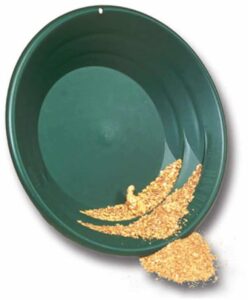
Gold Magnet: A gold magnet is an excellent tool for separating black sand from gold. It can also remove other minerals, such as hematite and magnetite. A portable 8 lb. magnet with a quick-release handle will work great.
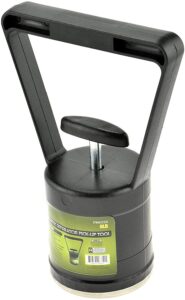
Pocket Separator Pen: The Black Sand Pocket Separator Pen is a great tool for separating gold from black sand. It can also remove other minerals, such as hematite and magnetite. This pen-like device uses a powerful magnet to extract the gold from the black sand. It’s small and portable so you can take it wherever you go.
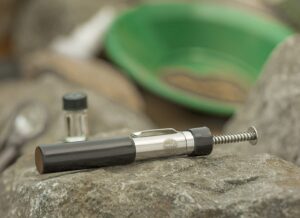
Blue Bowl Concentrator: The Blue Bowl Concentrator is a device that uses water to help separate gold from black sand. It is a popular tool for prospectors because it is easy to use and efficient.
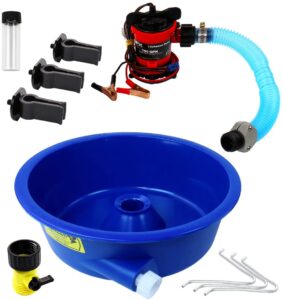
The Blue Bowl Concentrator works by creating a whirlpool effect. It’s a simple, easy-to-use tool that can separate gold from black sand. This process causes the gold to move away from the black sand.
Gold Spiral Wheel: The spiral wheel is a device that uses centrifugal force to separate gold from black sand. It works by spinning the material around in a circle. This effect causes the gold to pull away from the black sand. The Gold Spiral Wheel is a popular tool for prospectors because it is easy to use and efficient. Visit our post about the 5 Best Gold Spiral Wheel Concentrators to determine which option will work for your environment.
Gold Smelting Kit: Gold smelting kits use heat to separate gold from black sand. Most kits contain a furnace and crucible.
Castmaster Deluxe Gold Smelting Kit
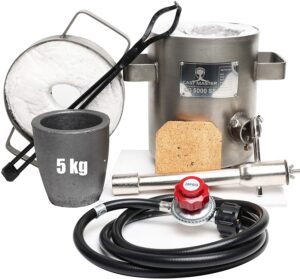
The furnace applies heat to the crucible, which melts the gold. Next, you pour the black sand into the crucible, and the gold is melted and separated from the sand. It can also remove other minerals, such as hematite and magnetite.
Black Sand With Gold FAQs
Is Gold Heavier Than Black Sand?
Gold is not necessarily heavier than black sand; however, the two materials have different densities, which means they will separate when placed in water.
Gold is commonly associated with such concentrates. This association is because black sand found in placer deposits is composed of several heavy elements that tend to boast a dark color and high specific gravity. Gold, just like black sand, is heavier than the surrounding materials commonly found in a streambed. – prospectingplanet.com
Gold is denser than black sand, so it will first settle to the bottom of a pan. Black sand is less dense than gold, so that it will float on top.
What Is A Black Sand Placer?
A black sand placer is a type of deposit where gold is found in the form of black sand. Black sand deposits are found worldwide and are a popular target for prospectors.
Black sand and gold are heavier than most surrounding materials and tend to collect in similar places within a stream or deposit. Black sand varies in composition from site to site.
The local geology largely determines the type of black sand found in an area. Black sand can be composed of many minerals, such as magnetite, hematite, ilmenite, chromite, and garnet.

Is All Black Sand Magnetic?
Not all black sand is magnetic. Because the composition of black sand depends on its geographical location, its characteristics will vary.
Most placer gold is associated with black sand, composed mainly of grains of magnetite (magnetic iron oxide). Still, it may contain varying proportions of hematite (non-magnetic iron oxide but rendered magnetic by heating), ilmenite (iron titanium oxide), pyrite and marcasite (iron sulfides), monazite (cerium, lanthanum, thorium phosphate), rutile (titanium oxide), scheelite (calcium tungstate), tourmaline (boron and aluminum silicate), wolframite (iron-manganese tungstate), zircon (zirconium silicate), chromite (iron oxide and chromium oxide), and other heavy minerals. – 911metallurgist.com
Do All Rivers Have Black Sand With Gold?
All rivers do not have black sand with gold. Black sand is more likely to be found in areas with a lot of volcanic activity, in placer deposits, or on a beach. Placer deposits are areas where gold has been deposited by water. They are typically found in streams and river beds.
Most rivers don’t contain gold. Gold is a heavy element and tends to be found in areas with geologic activity and erosion. Erosion happens when water washes away rocks and other materials. This occurrence can happen in larger rivers but more slowly than in streams.
Black Sand With Gold Conclusion
In conclusion, black sand with gold is a type of deposit that is found in many different places all over the world. The composition of black sand varies depending on the location. Black sand is usually heavier than other materials and tends to settle in similar places.
Gold is often associated with black sand because it is heavy and settles in similar places. If you are in an area rich with black sand, run a few sample tests and use the tools mentioned above to help you process the material efficiently.

